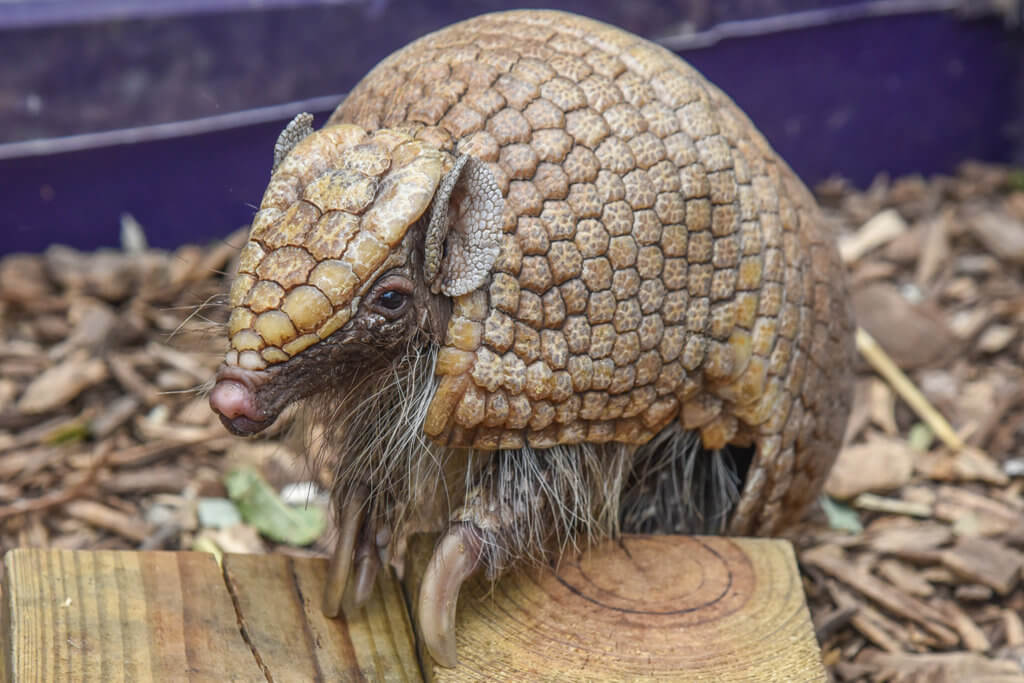Overview
“Where I live”
Southern three-banded armadillos are found primarily in dry forests and grasslands of Argentina, Boiva, Brazil, and Paraguay. They can also be found in and around agricultural fields. Although mainly nocturnal, armadillos may be a bit more active during the day when the weather is cooler.
“How I live there”
Southern three-banded armadillos are small mammals covered in an armor of hard, bony plates called scutes. Thanks to this armor, three-banded armadillos can move around confidently each night in search of ants and termites. During the day these armadillos rest in burrows to keep cool and safe. Southern three-banded armadillos rarely dig their own burrows, prefering to take over the abandoned burrows of other animals. If none are available, they will make temporary nests out of grasses and leaves.
“Making my mark”
The bony plates (scutes) of armadillos make them instantly recognizable. In southern three-banded armadillos, this protective adaptation goes a step further. When threatened, a southern three-banded armadillo can roll completely into a ball, shielding its soft belly. Small gaps between the curled-up armadillo’s scutes can pinch the skin or fingers of predators that try to pry open this potential meal.
“What eats me”
The bony armor of three-banded armadillos protects them from most animals. However, large mammals like jaguars and maned wolves can successfully hunt members of this species. Because their predators are mainly nocturnal, young armadillos will venture out in the late afternoon to return to the safety of their burrows earlier in the evening.
Southern three-banded armadillos are occasionally hunted by people for food, scute collecting, or the pet trade. Their defense strategy of curling into a ball makes these armadillos easy for humans to catch, meaning that humans can potentially become a major threat to southern three-banded armadillos.
Raising Young
Not much is known about three-banded armadillo reproduction and raising of young. Males and females may have overlapping home ranges that help them find mates. After mating, each quickly returns to its own burrow. After a 120-day gestation period, females give birth to one offspring. The infant armadillo looks like a smaller version of the adult, but has softer scutes. Young armadillos are raised by the female only, and are independent in just 72 days. After leaving its mother’s care, a young southern three-banded armadillo may share a home range with its mother for a short time.
Taxonomy
- Kingdom: Animalia
- Phylum: Chordata
- Subphylum: Vertebrata
- Class: Mammalia
- Order: Cingulata
- Family: Chlamyphoridae
- Genera: Tolypeutes
- Species: matacus
What is an Animal Ambassador?
The Maryland Zoo refers to its special collection of education program animals as “Animal Ambassadors.” The Zoo currently cares for more than 60 Animal Ambassadors, representing more than 40 species, both native and exotic. These animals are managed separately from the rest of the Zoo’s collection and cannot be seen on exhibit at the Zoo. However, many can be seen up close and personal on a rotating basis at Creature Encounters, the Zoo’s outdoor education center; at camp and school programs at the Zoo; as featured participants in community-based Outreach programs; and at special events on and off Zoo grounds.
Animal Ambassadors spend countless hours working with their human handlers, developing bonds of trust and communication that will allow them to appear in front of audiences large and small. They are not show animals. They behave naturally, focusing audiences’ attention on their natural behaviors and adaptations and giving living, breathing meaning to concepts and topics that students may be studying.
Animal Ambassadors travel all over the state of Maryland and beyond, and many also make local and national media appearances, educating about wildlife while representing the Zoo and its commitments to animal welfare and conservation.
What is The Animal Embassy?
The Animal Embassy at The Maryland Zoo is an off-exhibit area that is not open to the public. It is where the Zoo’s “Animal Ambassadors,” or education program animals, live. The Embassy is home to more than 60 individual animals representing more than 40 different species. It is staffed by its own dedicated group of keepers and volunteers and has both indoor and outdoor living space for the animals.

